Unsure about your French table manners? Click Here to download > > How to avoid these 10 food etiquette mistakes !
- Home ›
- Ze French ›
- La Gastronomie ›
- A French Traditional Breakfast
A Typical Breakfast in France (A REAL traditional french breakfast)
Updated 30 September 2025 by Leyla Alyanak — Parisian by birth, Lyonnaise by adoption, historian by passion
A typical breakfast in France may not be what you expect. Do you think we gorge ourselves with mountains of buttery croissants each morning? The reality is different: a tartine, some cereal, or yes, the occasional croissant.
Let's start by debunking Myth #1: we do NOT eat croissants for breakfast every single morning.
Reality, in fact, is far more banal: we DO eat croissants, but mostly on weekends, or if we're late and need to grab breakfast on the run.
At home? Occasionally.
If you’d like to taste a French breakfast for yourself, you can join this breakfast tour in Paris or even book an authentic French breakfast pastry class.
There are many exceptions and variations and we'll talk about all these below.
Oh, and how do you say breakfast in French?
A few facts about breakfast in France
Typical French breakfast foods
- La tartine
- Les viennoiseries
- Le croissant
- Le pain au chocolat
- Everything else
- Breakfast cereals
- A few other French breakfast items
Pronouncing French breakfast words - video
Foods the French do NOT eat for breakfast
NOTE: Pages on this site may contain affiliate links, which support this site. See full Privacy Policy here.
SUMMARY: WHAT IS A TYPICAL FRENCH BREAKFAST IN FRANCE?
- A tartine, or slice of baguette with butter and jam
- Viennoiseries (pastries) - may include croissant or pain au chocolat
- Fruit juice and a hot drink
A few facts about breakfast in France
For a country that prizes itself on culinary excellence, our breakfasts are surprisingly plain. In fact, breakfast is considered the least important meal of the day.
While in some countries breakfast contains savory elements – cheese, cold meats, eggs or bacon, ours tend to be sweet and carb-heavy. That’s why most guides describe the typical breakfast in France as a tartine and hot drink rather than a heavy meal.
So what are all those quiches, sandwiches, and other salty lovelies hot out of the oven? They're for lunch, of course, in case you plan to go sit on a park bench and have a picnic or if you're in a rush.
In rural areas, especially where there are local specialties or if you're eating on the farm, you might be served salami or cheese.
But the so-called English or American breakfast, a hefty meal, is only served in hotels with international-type buffets, or in highly touristed restaurants with an expanded French breakfast menu.
Also, many of us don't eat breakfast at all (shame on us!), rushing out the door with a cup of coffee and postponing gratification until lunch. (Breakfast may be plain, but other rituals aren't - like the French apéritif, a far more elaborate affair.)
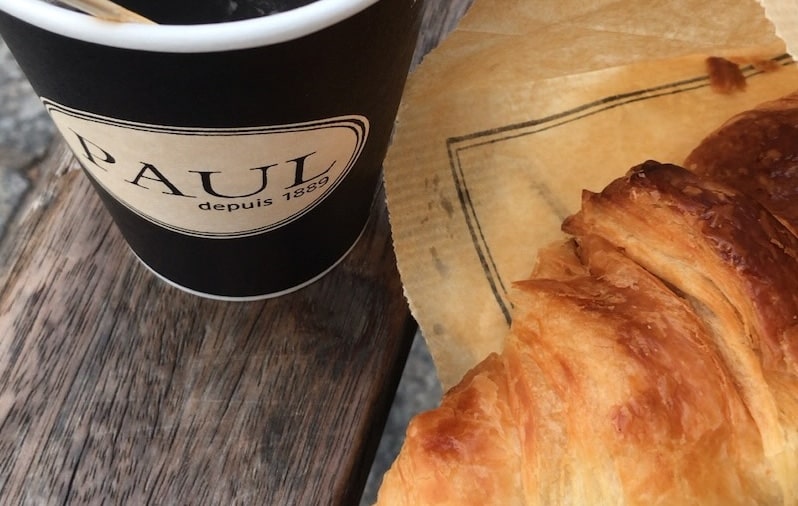 When I travel, I might grab a croissant for breakfast at the train station
When I travel, I might grab a croissant for breakfast at the train station
Typical French breakfast foods
Not everyone eats exactly the same thing for breakfast across France – there are plenty of regional and cultural variations – but these are the staples:
- la tartine (toast) – tar-TEEN
- les viennoiseries (pastries) — vee-en-was-REE
- jus de fruit (juice) – jhoo de froo-WEE
- boisson chaude (hot drink) – bwah-so-SHOWED
In other words, the standard breakfast will be a hot drink, like coffee or tea, a slice of baguette with butter and jam, possibly a pastry (or not), and maybe fruit juice. Rather boring. Kids, however, will also have cereal, and the habit is creeping into adulthood.
La tartine
There's no real translation for 'tartine' – it sometimes means toast but not made with the square, sliced stuff that passes for bread in some countries.
Usually it means a half or a quarter baguette, sliced horizontally, with butter and jam (or jelly). Sometimes the baguette is cut into small, round pieces, but that is rare and round slices are used mostly for lunch or dinner. At breakfast, you want to be able to "dunk" your tartine into your café-au-lait bowl... And the baguette may be grilled, though not necessarily so.
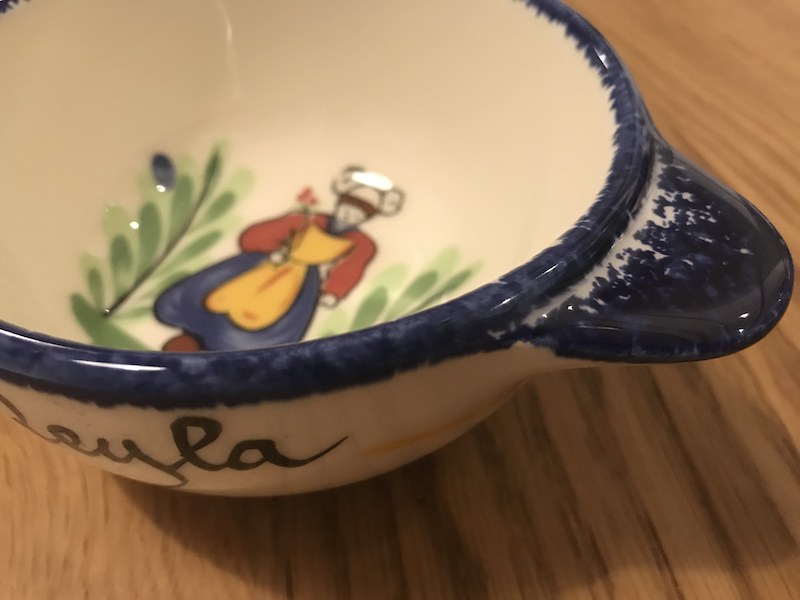 This is my personal breakfast bowl, and many French have these, especially older generations. Photo ©OffbeatFrance/Leyla Alyanak
This is my personal breakfast bowl, and many French have these, especially older generations. Photo ©OffbeatFrance/Leyla AlyanakEveryone has their favorite jam or jelly. The most popular (judging by the bare shelves in my local supermarket) are berries and marmalade, or honey. Jellies like quince are also well liked but breakfast toppings is one place where our individuality can shine. I, for example, am partial to classic Bonne Maman orange marmalade.
Butter is optional although common, and can be either unsalted (doux) or salted (salé). It really is a question of taste, and often of region.
An incredibly popular breakfast spread among both children and adults is Nutella, which France consumes more than any other country in the world.
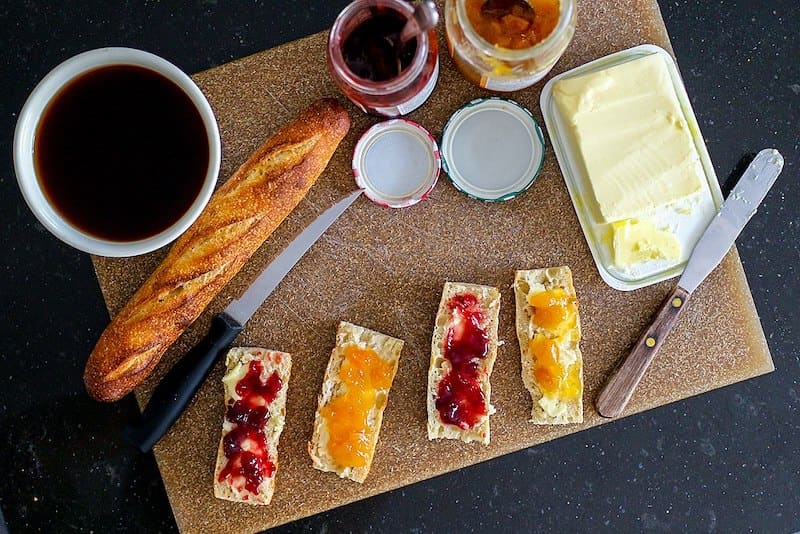 Welcome to a typical French breakfast, with tartines, butter, jam and a bowl of coffee. Photo by Nat via Wikimedia Commons CC BY-SA 4.0
Welcome to a typical French breakfast, with tartines, butter, jam and a bowl of coffee. Photo by Nat via Wikimedia Commons CC BY-SA 4.0Dunking is nothing new.
Around the 16th century, as the story goes, someone began dunking buttered bread into milk (coffee wouldn't make an appearance in France for another century or so).
Once coffee became the queen of beverages, the dunking habit stuck, but breakfast as such didn't become popular until the 1800s, and even then, it was mostly a city thing, becoming increasingly widespread during the Belle Epoque.
By mid-20th century, today's breakfast had become the norm.
Les viennoiseries
This translates roughly into "from Vienna", which is where it is believed France's flaky breakfast buns originated.
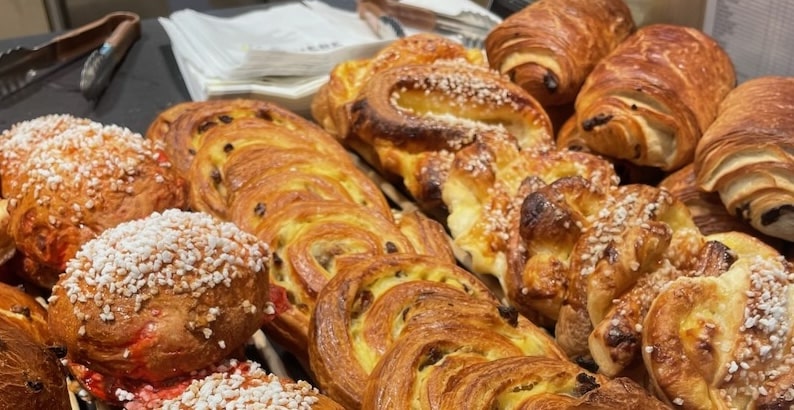 A typical spread of viennoiseries in a French boulangerie, or bakery
A typical spread of viennoiseries in a French boulangerie, or bakeryUnless you're grabbing one at the boulangerie on the way to work, these are rarely eaten on weekday mornings. One exception is when you're staying in a hotel, which usually serves these pastries along with some kind of buffet for breakfast. There are a few other exceptions, as I'll explain below.
There are many different viennoiseries, enough to keep you full for many breakfasts. You can sample some of them in this hands-on baking experience near the Eiffel Tower.
Le croissant
The croissant is the most famous of the viennoiseries and would seem to trace its ancestry to the Austrian kipferl, shaped as a crescent because it was first designed to celebrate a victory over the Ottomans. That's one story.
In another, a Viennese baker moved to Paris and served kipferl to his bakery clients. The discerning Parisians fell in love, adopted it, changed it significantly, and turned it into the croissant we know today.
Sadly, there is no evidence to confirm these and several other stories of the croissant's origins. But frankly, who cares where it came from... what's important is that we have it today.
There are several common types of croissant, these being the most common:
- plain croissant, or croissant ordinaire: these lack that rounded deliciousness and tend to be dry because they are not made with butter (these are becoming rarer) – they taste a bit like brioche
- croissant au beurre: the buttered croissant tends to be the preferred croissant for those who can eat butter, and is made with rich, succulent butter (you'll need to wipe the leftover butter off your hands after you eat one)
- croissant aux amandes: this is extremely sweet, usually filled with almond cream and covered in toasted shaved almonds and powdered sugar (a diet buster and sugar boost like no other, but oh, quel délice!)
Croissants may not be everyday breakfast fare, but when they show up, they're inevitably appreciated. Or you could learn to make your own.
 My own Sunday stash of croissants, picked up fresh from the boulangerie in the morning for friends coming over for brunch ©️OffbeatFrance/Leyla Alyanak
My own Sunday stash of croissants, picked up fresh from the boulangerie in the morning for friends coming over for brunch ©️OffbeatFrance/Leyla AlyanakLe pain au chocolat
Known in some English-speaking countries as a chocolate croissant, this one almost rivals the croissant in popularity.
It is often eaten by children and students in mid-afternoon for their goûter, or snack. For the rest of us, the pain au chocolat is reserved for weekends, as a special treat, perhaps on Valentine's Day, or, like the croissant, for the occasional disorganized early morning rush.
Should you be visiting southwestern France, best to ask for a chocolatine instead. A "friendly" cultural tussle (video) has been going on for years, with each claiming the correct name for this delightful French breakfast pastry.
Both are correct, and both taste the same.
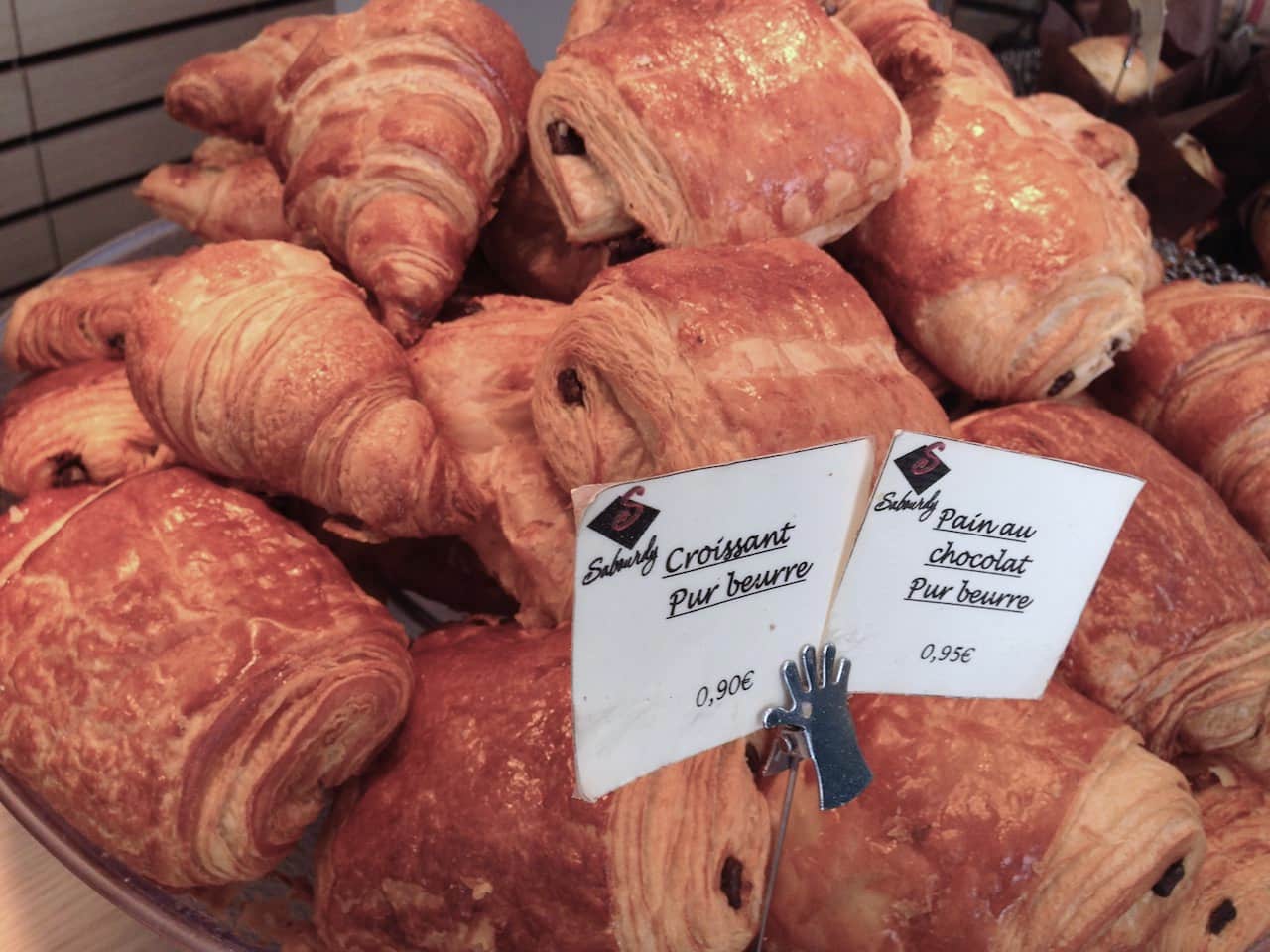 A trip to the boulangerie: croissants and pains au chocolat - not every day, but often enough! ©️OffbeatFrance/Leyla Alyanak
A trip to the boulangerie: croissants and pains au chocolat - not every day, but often enough! ©️OffbeatFrance/Leyla AlyanakEverything else
Your local bakery will have plenty of viennoiseries. In addition to the basic croissants and pain au chocolat, you'll usually find:
- pain au raisin: not unlike cinnamon rolls
- escargots (not REAL snails but shaped like one), a bit like the pain au raisins but without the raisins
- palmier, a flaky and sweet heart-shaped puff pastry covered in crunchy, caramelized sugar – everyone will know what you had for breakfast because it is impossible to get rid of every single crumb you'll be wearing!
A word about freshness
It is a sad state of affairs but these days, few bakers prepare everything from scratch. Often, they receive dough from a central sales point (or, horror of horrors, buy frozen dough) and bake or reheat things in their ovens.
SUMMING UP: HOW TO SPOT AN ARTISAN BAKERY
Look for these words: "Artisan Boulanger", "Fait Maison", or "Boulangers de France". And look at the breakfast pastries... if they are identical in shape or part of huge displays, go on your way - they're probably industrial.
While the ingredients in a baguette or several breads are highly regulated, you cannot say the same about viennoiseries: there is no legislation that prevents bakeries from selling you an industrial croissant.
So how can you tell?
- Avoid franchises. I can't give you the names but if you see boulangeries with the same name and logo in several different towns, you might reconsider.
- If yours is a small boulangerie and you have a huge choice of pastries, you might ask yourself how that tiny kitchen with its single baker can turn out an such an array of viennoiseries...
- Look for irregularities. If each item is identical, there's a good chance the entire lot comes from an industrial plant.
- Artisanal pastries are made with butter, eggs, high-quality flour. Industrial ones may use margarine, powdered eggs, cheap flour... sometimes, you can just tell by the taste.
WHY NOT MAKE YOUR OWN BAGUETTE?
- There's little that can beat the incredible aroma of a freshly baked baguette, and French Bread Baking for Beginners lifts the veil of secrecy on this French delicacy!
- A professional proofing cloth is key to your baguette creation – made of natural linen, as it should be.
- Use this baguette pan to get the size of your baguette just right, not too long and not too wide. An essential part of your French kitchen!
Local bakeries that make their own bread and pastries will usually say so right on their sign, with a mention like "Artisan Boulanger" (an artisan), "Fait Maison" (home-made), or "Boulangers de France", a network of artisanal bakers.
It's not a foolproof method, because some industrial franchises may use words that hint at home-made, skating near the edge of the law.
In the end, you'll have to trust your nose and your taste, because there is really no failsafe way of knowing.
Each year, France has a television show called "La Meilleure Boulangerie de France", a contest that selects the best bakery. By looking at the list of winners and finalists, you'll at least be able to sample what they offer if you happen to be in that part of the country...
Meantime, for an expert guide into the world of French baking and pastries, consider taking one of these tours. You'll learn about baguettes and croque-monsieurs, of course, but you'll branch out, making it easier to understand all those French menus.
Breakfast cereals
Let's face it, breakfast in France is changing.
Cereals are becoming a staple of the typical French breakfast, at least among children and the younger generation. Plenty of ads on television enjoin us to eat cereals, and they are having an impact.
According to one survey several years ago, 59% of French ate cereal for breakfast. Going forward, that number can only have increased.
With cereals, all you have to do is pour into a bowl and add milk, no fuss, no muss. The temptation of simplicity in a busy world is understandable.
I suspect this might be more common in the cities, because where I live, in rural Eastern France, I don't know a single person beyond their teens who eats cereal... we're tartine die-hards out here.
A few other French breakfast items
Of course there are always a few who buck the norm and eat differently, although here too, habits are slowly evolving.
One trend is the sale of specialty breads in bakeries. A decade ago, in my local boulangerie, I could buy a few different baguettes, a crown-shaped loaf, some larger breads called pains (this is the generic word for bread but is also a loaf about twice the size of a baguette), and a very few others.
Now, I can find several dark breads, baguettes with seeds on top, breads with cheese or bacon or olives, tall loaves and flat loaves and rye or linseed loaves. This diversity is extremely welcome, but it was a long time coming.
 All the breads now available in my local bakery ©OffbeatFrance/Leyla Alyanak
All the breads now available in my local bakery ©OffbeatFrance/Leyla AlyanakThe so-called healthy breakfast is also making inroads in certain quarters. It might include muesli or a healthy cereal, yoghourt, fruit – anything that isn't a refined grain.
Brunch on weekends is becoming popular in large cities where it is available, and that's where you might find such dishes as Eggs Benedict or pancakes or a full English or American breakfast.
Now, radishes.
What??
I used to think this was a peculiarity of my mother's, cutting a radish, slipping some butter into the gashes and sprinkling with salt.
But no. I've since seen these at friends' homes for breakfast. Neither unique nor widespread, this breakfast choice is a bit quirky and demonstrates we are not all that stuffy when it comes to breakfast.
Typical French breakfast in a hotel
A hotel buffet is where you'll find the kind of international breakfast you may be used to, complete with hot dishes, meats and cheeses. If you're desperate for a hot breakfast, head for a hotel!
Typical French breakfast in a café
It's a common sight, people sitting at a café table with a croissant and a coffee. In many cafés, you can get a quick breakfast in the morning, but ask for a croissant at 11am and there's every chance they'll have run out. An early-morning run to the bakery for croissants, and that's about it.
Near tourist attractions, a "full breakfast", sometimes including eggs, is on offer. I was quite surprised to sit down for breakfast at a café near the Musée d'Orsay in Paris and spotting such things as eggs and bacon as part of a set menu called "Petit Déjeuner Américain". Of course.
Pronouncing French breakfast words - video
Foods the French do NOT eat for breakfast
There are plenty of foods that people may think we eat for breakfast... but that we do not.
- French toast: this may sound like one of the typical French style breakfast foods, but I have yet to see it eaten at the regular breakfast table. The French for French toast is pain perdu, or lost bread; this dish occasionally pops up on weekends or even at suppertime.
- Crêpes, or pancakes: while pancakes may be popular for breakfast in North America, they're rarely eaten at the French breakfast table. Like pain perdu, they tend to appear on weekends or for a light lunch or supper. Unlike their anglophone cousins' slathered syrup, they tend to be eaten with powdered sugar, lemon, honey or a stuffing of sorts, like chocolate sauce or chestnut cream. What we call crêpes are eaten for lunch, with a salad.
- Meat spreads or pâté: In some countries, pulling out the pâté is believed to be the summit of French breakfasts. Not in France. These dishes are eaten before a main lunch or dinner dish, or as a light meal on their own but never for breakfast, unlike in neighbouring Germanic countries, where cold cuts for breakfast are common.
- Eggs and bacon: As I mentioned above, these are brunch foods, or breakfast foods when you happen to be staying in a hotel, but not at home, or rarely.
- Cheese: This is another item that hasn't found its way to the breakfast table. On the contrary, it is typically eaten to end a meal like lunch or dinner.
 One of my favorite crêpes, with apple, salted caramel, and ice cream - a bit rich for breakfast, no? ©OffbeatFrance/Leyla Alyanak
One of my favorite crêpes, with apple, salted caramel, and ice cream - a bit rich for breakfast, no? ©OffbeatFrance/Leyla AlyanakWhat the French drink for breakfast
Morning hot drinks are quite similar to those in other countries:
- Coffee, usually café au lait, which when I was a child was drunk in a bowl rather than a cup or a mug. Modern tastes allow for cappuccinos at breakfast, with the occasional espresso thrown in. (If you know anyone in Europe to whom you can ship, you can order your own bowl here.)
- Chicory, or chicory mixed with coffee, although this tends to be a regional drink and not available everywhere (having tasted this, I'd have to say its scarcity is a good thing)
- Tea, usually with lemon or with milk, with loose teas becoming increasingly popular
- Herbal teas, or tisanes, some of which you'll easily find anywhere, even in cafés, such as mint (menthe), linden tea (tilleul) or verbena (verveine)
- Hot chocolate, or chocolat chaud, for those who don't want caffeine and don't like tea. Of course this is particularly liked by children (and the adult writing this)
- Fruit juice: This is common at breakfast, as evidenced by the rows upon rows of fruit juices you'll find in any supermarket
THINKING OF LEARNING FRENCH?
If you'd like to learn quickly...
French Today is a different kind of French course, one that teaches French as it's spoken in everyday life. Try it out!
✔︎ No stuffy grammar (but you DO learn to speak correctly)
✔︎ Modern pronunciations, with audio guides that are easy to follow
✔︎ Full, 100% money-back guarantee - it's THAT good
✔︎ 2.5hr free French audiobook - try before you buy
If you've ever considered learning French, this novel, user-friendly course will teach you faster than you can say "S'il vous plaît!"
This seems a good time to tell you about the canard, or duck (a term which may come from the way ducks dunk themselves into the water and come out soaked). A canard is a sugar cube dunked in coffee (or in some sort of alcohol, but not usually at breakfast). And at least one friend of mine uses the term canard for her dunked tartine.
And to explore the world of French culinary specialties even further, here are some additional tours that will grow your expertise.
FAQ
How do you say breakfast menu in French?
How do you say breakfast menu in French?
La carte du petit déjeuner.
Do the French eat croissants every day?
Do the French eat croissants every day?
No - croissants are usually for weekends or cafés. A weekday breakfast is a tartine with coffee or tea.
What time is breakfast in France?
What time is breakfast in France?
At home, usually between 7:00-9:00. Cafés stop serving breakfast around 10:30 or 11:00.
Before you go...
It's true, our French breakfasts may not be stellar, but it's all in the quality of the ingredients: the crunchy baguette, the rich butter, the barely sweetened jam... it's all good, every bit as good as the rest of the foods we love in France.
Did you enjoy this article? I'd love if you shared it!


